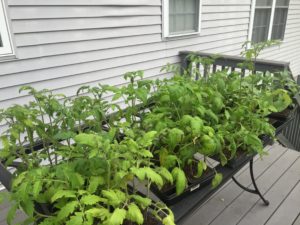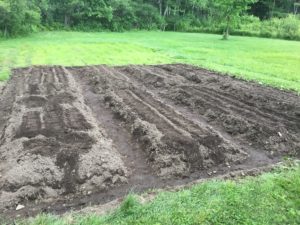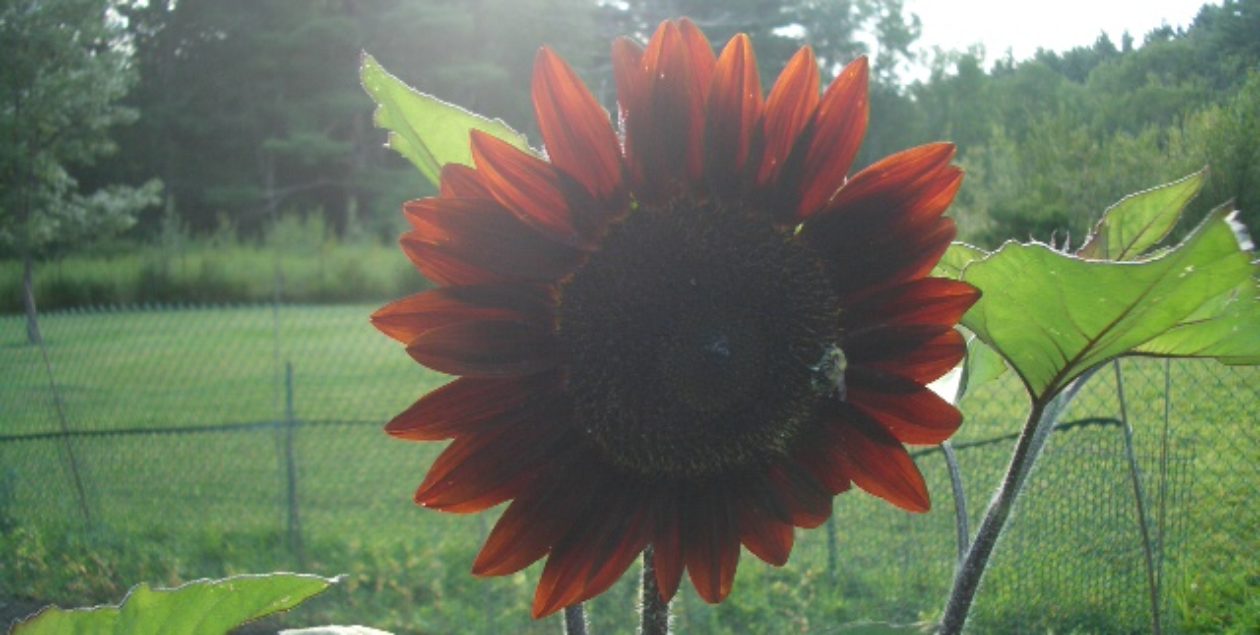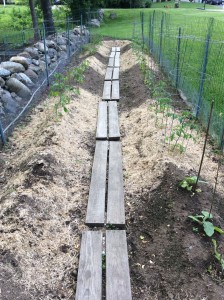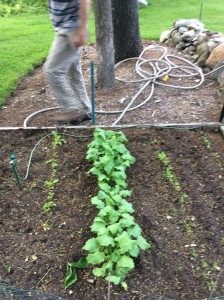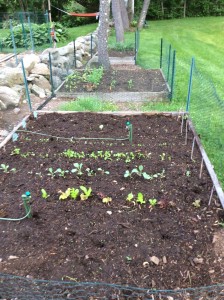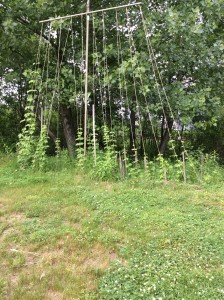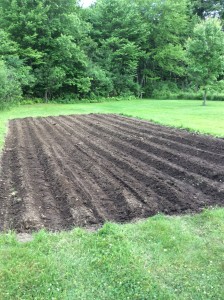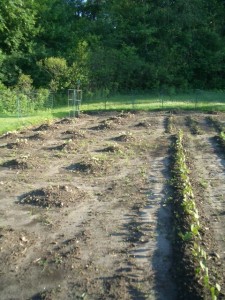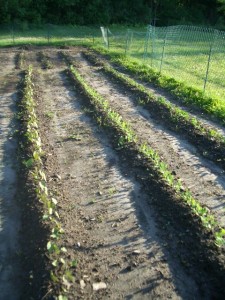In my last post, I mentioned the purchase of the John Deere garden tractor. J was very specific in the type, vintage and condition he wanted, which is why it took almost 5 months to find the right one in the right price range. However, given how expensive they are new, this was worth the effort. Especially since I didn’t have to do anything except say, “Whatever you want, dear,” and “I think that’s a good price,” and “I’d be happy to go with you to pick up the tractor.” Which I said. Repeatedly. For five months. Don’t get me wrong, this is probably one of the best things ever – there was zero effort involved on my part except some verbal reassurance AND now I get a ride-on tractor to do the lawn instead of having to use a push mower. Win-win.
It’s more than just the tractor, though – it’s the accessories necessary for the larger garden. It started with the rototiller, which appeared in our garage even before the right tractor had been located. That sucker is big. And rusty, which is par for the course when you purchase a piece of equipment that rips up the dirt as you drag it behind the tractor. It’s apparently of early 1960’s vintage if J’s research is right, which explains the rust. Then came the plow, which is currently in pieces in the basement, being painstakingly restored. A few weeks later a mulching kit arrived via U.S. post, an EBay purchase. Somewhere in between the hydraulic lift was acquired, the details of that acquisition still fuzzy to me. Someone might have actually brought it to the house for him. And over Valentine’s Day weekend we travelled out to the MA / NY border to pick up the remaining parts for the mower’s bagger and a 6-gallon attachable sprayer. He’s still on the hunt for a garden cart, and probably a few other things he hasn’t admitted to yet.
But I know he’s most excited about the plow, mainly because every time I go into the basement he’s fiddling with it and he spends time on John Deere posting boards reading up on plowing techniques. The garden is making a big jump this year, from the fenced-in 8′ x 20′ plot to that, plus 2 raised beds, and an open field section for the corn, pumpkins and watermelons. We need the plow and the rototiller in order to be able to put in the three hundred stalks of corn and the four types of pumpkins and the watermelons. (I will post the garden plans soon, along with the seed lists. The sheer number of plants and the ambitions of this year’s garden sometimes overwhelm me. But then I remember, we have a tractor! Won’t that help?)
Over the weekend J apparently read this on one of his boards and sent it to me to post here. I like that it’s from a website called “Weekend Freedom Machines” which tells you something about the sort of people who describe tractors like that. The author is unknown, but if someone ever uncovers who wrote this let me know as I like to give credit where credit is due. If you make it all the way through the text, bless your cotton socks. I promise more pictures in upcoming posts, rather than all this text.
From “Weekend Freedom Machines, ” a vintage John Deere garden tractor website. Author unknown:
One of the oldest and most valuable tillage tools of agricultural history, the plow has transformed many millions (probably billions) of acres of land into a productive seed bed. Through the ages, good plowing had been the soil’s best friend by preparing a seed bed with a minimum of time and effort, helping to control weeds, assisting in the degradation of mulch into organic matter, increasing water retention, and reducing erosion. One of the oldest plows known to exist (said to date from 2000 BC) is a testament to the timelessness of this tillage practice. When plowing, a farmer is part of fraternity that spans many continents and generations. Plowing contests are more than turning over soil, they are a celebration of tradition, agriculture and friendships.
Skillful plowing provides many benefits for the soil:
1.) Furrows that are turned over at the proper angle create a furrow comb (ridges and valleys) that makes an excellent seed bed. Clods and holes should be avoided as they allow seeds to fall too deep or cause it to lay on top. A farmer should be able to broadcast seed over the plowed field and harrow it lightly to incorporate the seed at a uniform depth. Once the crop emerges, rows should be visable.
2.) The furrow comb also helps to slow the wind at ground level. This reduces the amount of soil that blows away and helps to deposit snow in the depressions. On hilly land, contour plowing slows water runoff which reduces erosion and improves moisture absorption.
3.) Weed control can be achieved with good plowing. Furrow slices that are properly cut off, rolled over, and placed tightly against the next furrow bury growing weeds and weed seed deeply enough to help prevent weed growth and seed germination. An extra weed control measure may be taken by plowing a split and then placing the crown on top of that. The split shaves off all growing plants at ground level so they do not grow through the crown placed on top of them.
A good job of plowing also helps maintain a field that is easy to work with:
1.) An opening crown that is level with or only slightly higher than the surrounding furrows is preferred to one that is too high as it is easier to maintain proper seed depth for good germination and is more comfortable to drive over for the farmer.
2.) The closing furrow should be narrow and shallow while still maintaining furrow conformation and trash coverage. This will help insure the best possible seed placement at planting time and reduce the depression that runs through the field for years to come.
3.) The plow should be placed into and taken out of the ground quickly and uniformly across the field so that the ins and outs may be cleaned up with only one pass of the plow. Anyone who has plowed an uneven headland knows how rough bouncing through furrows can be.
4.) From year to year, opening furrows should be placed over last year’s dead furrow to “unplow” ridges and depressions. This requires planning and skill with a plow.
The plow itself is an excellent educator for those interested in agriculture. The same attention to the details of fine plowing would serve a farmer well in choosing chemical, seed and fertilizer programs, making equipment adjustments, and selecting farming practices. With today’s small profit margins, this attention to detail may be the difference between making money of losing it.
There will never be a profit margin for us. Our very first year my mother commented that each tomato would probably cost $82. It probably was not that much then, but it might be that much now….
